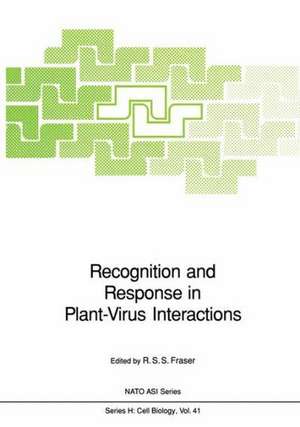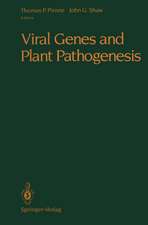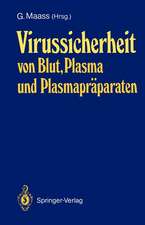Recognition and Response in Plant-Virus Interactions: Nato ASI Subseries H:, cartea 41
Editat de Ronald S. S. Fraseren Limba Engleză Paperback – 16 dec 2011
Din seria Nato ASI Subseries H:
- 18%
 Preț: 953.82 lei
Preț: 953.82 lei -
 Preț: 393.13 lei
Preț: 393.13 lei - 15%
 Preț: 643.34 lei
Preț: 643.34 lei - 15%
 Preț: 643.34 lei
Preț: 643.34 lei - 15%
 Preț: 641.03 lei
Preț: 641.03 lei - 15%
 Preț: 642.83 lei
Preț: 642.83 lei - 15%
 Preț: 642.51 lei
Preț: 642.51 lei - 5%
 Preț: 712.81 lei
Preț: 712.81 lei -
 Preț: 392.97 lei
Preț: 392.97 lei - 15%
 Preț: 651.02 lei
Preț: 651.02 lei - 15%
 Preț: 640.24 lei
Preț: 640.24 lei - 18%
 Preț: 948.61 lei
Preț: 948.61 lei - 15%
 Preț: 655.92 lei
Preț: 655.92 lei - 15%
 Preț: 655.92 lei
Preț: 655.92 lei - 15%
 Preț: 653.14 lei
Preț: 653.14 lei - 15%
 Preț: 650.19 lei
Preț: 650.19 lei - 15%
 Preț: 655.13 lei
Preț: 655.13 lei - 15%
 Preț: 652.17 lei
Preț: 652.17 lei - 15%
 Preț: 675.58 lei
Preț: 675.58 lei - 18%
 Preț: 958.07 lei
Preț: 958.07 lei - 18%
 Preț: 961.41 lei
Preț: 961.41 lei - 18%
 Preț: 970.56 lei
Preț: 970.56 lei - 5%
 Preț: 1100.30 lei
Preț: 1100.30 lei - 5%
 Preț: 376.43 lei
Preț: 376.43 lei - 15%
 Preț: 650.86 lei
Preț: 650.86 lei - 15%
 Preț: 644.63 lei
Preț: 644.63 lei - 15%
 Preț: 655.60 lei
Preț: 655.60 lei - 18%
 Preț: 963.47 lei
Preț: 963.47 lei - 15%
 Preț: 648.42 lei
Preț: 648.42 lei - 5%
 Preț: 731.43 lei
Preț: 731.43 lei - 15%
 Preț: 653.14 lei
Preț: 653.14 lei - 18%
 Preț: 960.13 lei
Preț: 960.13 lei - 18%
 Preț: 968.34 lei
Preț: 968.34 lei - 18%
 Preț: 953.97 lei
Preț: 953.97 lei - 15%
 Preț: 654.95 lei
Preț: 654.95 lei - 15%
 Preț: 652.49 lei
Preț: 652.49 lei - 15%
 Preț: 650.86 lei
Preț: 650.86 lei - 5%
 Preț: 367.64 lei
Preț: 367.64 lei - 5%
 Preț: 1104.68 lei
Preț: 1104.68 lei - 18%
 Preț: 953.20 lei
Preț: 953.20 lei - 15%
 Preț: 651.99 lei
Preț: 651.99 lei - 15%
 Preț: 647.27 lei
Preț: 647.27 lei - 15%
 Preț: 656.25 lei
Preț: 656.25 lei - 18%
 Preț: 962.35 lei
Preț: 962.35 lei - 15%
 Preț: 644.82 lei
Preț: 644.82 lei - 15%
 Preț: 666.55 lei
Preț: 666.55 lei - 15%
 Preț: 642.68 lei
Preț: 642.68 lei - 15%
 Preț: 645.96 lei
Preț: 645.96 lei - 15%
 Preț: 651.84 lei
Preț: 651.84 lei
Preț: 653.00 lei
Preț vechi: 768.23 lei
-15% Nou
Puncte Express: 980
Preț estimativ în valută:
124.95€ • 130.81$ • 103.39£
124.95€ • 130.81$ • 103.39£
Carte tipărită la comandă
Livrare economică 05-19 aprilie
Preluare comenzi: 021 569.72.76
Specificații
ISBN-13: 9783642741661
ISBN-10: 3642741665
Pagini: 484
Ilustrații: IX, 467 p.
Dimensiuni: 170 x 242 x 25 mm
Greutate: 0.77 kg
Ediția:Softcover reprint of the original 1st ed. 1990
Editura: Springer Berlin, Heidelberg
Colecția Springer
Seria Nato ASI Subseries H:
Locul publicării:Berlin, Heidelberg, Germany
ISBN-10: 3642741665
Pagini: 484
Ilustrații: IX, 467 p.
Dimensiuni: 170 x 242 x 25 mm
Greutate: 0.77 kg
Ediția:Softcover reprint of the original 1st ed. 1990
Editura: Springer Berlin, Heidelberg
Colecția Springer
Seria Nato ASI Subseries H:
Locul publicării:Berlin, Heidelberg, Germany
Public țintă
ResearchCuprins
Section 1. Introduction and Comparative Studies.- Recognition and response in plant-virus interactions: some underlying concepts.- Recognition in resistance to bacteria.- Recognition and response in plant-fungus interactions.- Section 2 Plant-Virus Interactions: Transmission, Host Range and Genetics.- Specificity and recognition events in the transmission of plant viruses by vectors.- The genetics of plant-virus interactions: mechanisms controlling host range, resistance and virulence.- Plant virus epidemiology: the battle of the genes.- Section 3. Molecular Mechanisms of Plant-Virus Interaction. I. Infection, Replication and Spread.- Signals and structures involved in early interactions between plants and viruses or pseudoviruses.- Genetic organization, evolution and expression of plant viral RNA genomes.- Replication of plant RNA viruses in vivo in relation to virus-host interactions.- Viroid replication mechanisms.- The movement protein of some plant viruses.- Section 4. Molecular Mechanisms of Interaction. II. Pathogenesis and Symptom Formation.- Signalling in viroid pathogenesis.- The molecular biology of satellite RNA from cucumber mosaic virus.- Cryptic viruses of beet and other plants.- Plant growth regulators, viruses and plant growth.- Recognition and disease development in the tobacco-TMV system.- Entry of tobacco mosaic virus RNA into tobacco chloroplasts in vivo and in vitro.- Section 5. Recognition and Response in Resistance and Virulence.- Modifications of the coat protein gene of tobacco mosaic virus resulting in the induction of necrosis.- Hypersensitivity to tobacco mosaic virus in N’-gene hosts: which viral genes are involved?.- Induction of plant genes by compatible and incompatible virus-plant interactions.- Defence proteins, glycanhydrolases andoligosaccharide signals in plant-virus interactions.- Inhibitor of virus replication associated with resistance responses.- Intercellular spread of potato leafroll luteovirus: effects of co-infection and plant resistance.- Section 6. Exploiting Signalling in Crop Protection.- Examination of mechanisms of cross protection with non-transgenic plants.- Coat protein-mediated protection against virus infection.- The use and misuse of viruses in cloning and expression in plants.
















